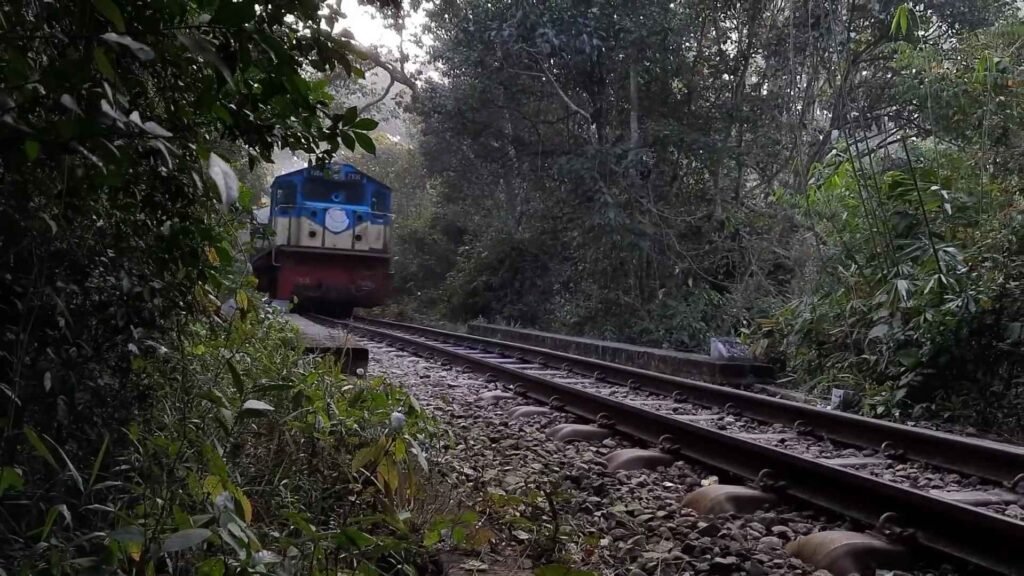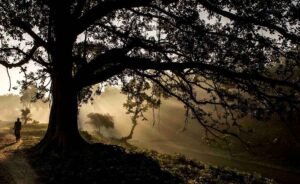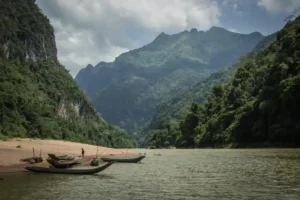Why you need to Travel in Bangladesh ? Home /...
Read MoreBy Train from Dhaka to Sylhet : An Unforgettable Thrilling Adventure
Experience a scenic train journey from Dhaka to Sylhet on the Parabat Express—lush tea gardens, rivers, and hills await nature lovers and adventure seekers.
By Train from Dhaka to Sylhet : An Unforgettable Thrilling Adventure
Jhok jhok jhok the train goes by,
Through moonlit fields and starry sky.
Racing the wind, so fast, so free,
Its home is where its dreams may be.
This is the train’s home—the central railway station of Kamalapur in the capital, Dhaka. The reason for coming to this train’s home is that, as children, we all had to write an essay titled “A Journey by Train” in our exam papers. And today, we are here to experience that journey firsthand.
We are taking you along on this railway journey. Keep reading to experience this thrilling adventure. Designed by architects Daniel Dunham and Bob Buoy, this station stands tall with 36 square domes on its roof, supported by 49 columns, reaching a height of 59 feet.
A Journey by Train
Every day, nearly 115,000 passengers step onto the platforms of Kamalapur Railway Station. With seven railway tracks and eight platforms, this station is one of the busiest in the country. Our train journey is headed toward the northeastern city of Sylhet. As soon as the whistle blows, our Sylhet adventure begins. In the Sylheti dialect, they say, “Ekhoto nachiya budi, tar ufore dolor badi.“
Being a travel enthusiast, this trip excites me even more—especially by train! With the driver’s command, the powerful engine has begun turning the massive, windless iron wheels, ready to take us on this thrilling ride.

The Scenic Escape from Dhaka to Sylhet
Rolling along the tracks is one of the four intercity trains from Dhaka to Sylhet, the Parabat Express. The concrete sprawl of Dhaka continues to grow denser, and so, whenever the opportunity arises, I escape to greener surroundings.
Many travelers claim that the Dhaka-Sylhet railway is the most beautiful train route in all of Bangladesh, offering a welcome breath of fresh air for those yearning for nature.
Aboard from Kamalapur
Our journey officially begins at Airport Station, just 18 kilometers from Kamalapur. Passengers wait eagerly, and as the Parabat Express arrives, a flurry of activity unfolds—people rushing to get on and off, the usual lively chaos of a busy station. This stop is especially useful for those heading to Shahjalal International Airport.
As the train pulls away, its horn pierces the air—a sound used by the Loco Master (yes, that’s what we call a train driver!) to communicate commands or warnings along the way. While train systems began in England nearly two centuries ago, Bangladesh has had trains for over 160 years.
Facts, Terms, and the Beauty of Simplicity
In railway terms, “Up” refers to a train departing from the central point, while “Down” indicates its return. Interestingly, a “bogie” isn’t the same as a “coach”—the bogie is the wheel-based base, while the coach is the upper structure where passengers sit.
For those of us living amid city life, experiencing open green fields, quiet forests, or rolling hills isn’t always easy. But through the window of a moving train on this route, that lost connection with nature is beautifully restored.
A Station Born of Influence and Heritage
As the train glides through Bangladesh’s lush green countryside, the sense of restlessness starts to fade. One of the first highlights of the journey is crossing the Shitalakshya River before reaching Ghoghashal Fag station.
Though the main station was two kilometers away, influential zamindar and British magistrate Haji Mohammad Abu Said insisted the train stop closer to his home.
In 1914, his request led to the establishment of Ghoghashal Fag station—the country’s first double-decker station. The Parabat Express, however, never halts here; it simply passes through—a railway term known as a “through pass.”
Bridges, Junctions, and Timeless Connections
About 40 kilometers ahead lies Bhairab Bazar, the first of three major junctions on the Dhaka–Sylhet route. A junction is where multiple rail lines and track points meet.
Beyond Bhairab stretches the historic Ashuganj-Bhairab railway bridge, named after King George VI and Sher-e-Bangla A. K. Fazlul Huq. This site features three structures—two rail bridges and one road bridge—each witnessing the tide of time.
The Meghna River bridge, a nearly 88-year-old steel marvel from the British era, requires trains to slow as they cross. It was inaugurated first in 1937 by Fazlul Huq and again in 1973 by Sheikh Mujib.
As the train hums past golden fields, memories of Pather Panchali emerge—Apu and Durga chasing the train, a scene forever etched into the heart of Bengal. This bond between train journeys and rural life in Bangladesh remains deeply poetic.
Train Ticket Examiner (TTE)
On the way from Dhaka to Sylhet, there are nine districts to pass through. Having already left Gazipur, Narsingdi, and Kishoreganj behind, the next ones are Brahmanbaria, followed by Habiganj and Moulvibazar.
Once aboard the train, you’re bound to meet the TTE (Train Ticket Examiner), who checks if passengers have valid tickets.
Thanks to digital technology, there’s no need to stand in line to buy tickets anymore. You can now collect your train tickets online. On the Dhaka-Sylhet railway route, the meter-gauge line typically reaches speeds of 45 to 50 km/h.
Once the dual gauge project is completed, the train will be able to run at even higher speeds. This will reduce travel time. On this moving train, you can stop it anytime if you wish. Pulling the stop chain in the middle of the coach will make the train halt.
However, the chain should only be pulled for safety, health, or emergency reasons. Pulling it unnecessarily or for trivial reasons may result in jail time or fines.
The train has a separate dining coach. When you place an order, the dining staff will serve your meal. You can even choose to eat in your seat if you prefer. The Parabat runs with 16 green coaches.
These coaches, made in Indonesia, are designed for meter-gauge tracks. The train is now at the Akhaura Azampur Railway Station, which was built in 1896.
Alongside passengers, Bangladesh Railway also transports goods. Freight trains often carry commercial products, and sometimes they haul oil tankers.
The train has reached Noyapara station, 40 kilometers from Azampur, where the 9:30 AM passengers are waiting.
Shaistaganj Station
In the last three hours, the train has covered approximately 183 kilometers. Although the journey stop is over, Parabat is still halted to allow the down train to pass. This system is in place to ensure smooth operation of multiple trains on the same railway line.
With the track now clear, the Parabat train is moving forward along the cleared line, thanks to the engineering technique known as “crossover turnout.” The next destination is Shaistaganj.
When a station connects to three different destinations, it is no longer just a station; it becomes a junction. From Shaistaganj, four railway lines spread out in different directions, with 23 stations along the way. This makes Shaistaganj a renowned junction.
On the train, there is a Train In-charge whose responsibility is total monitoring, such as ensuring passengers’ comfort, addressing technical issues, and providing first aid if needed.
Suddenly, the scenery along the railway tracks starts changing. The train has now begun to race through rows of tea gardens, hills, and dense forests on its way to Sylhet.
It truly feels amazing. Now, I can understand why everyone calls the Dhaka-Sylhet route the most beautiful railway route. Tea gardens are abundant on the Dhaka-Habiganj-Sylhet route, and during this journey, you will have plenty of opportunities to enjoy the sight of these scenic tea plantations.
The Green Tea Valley
The tea producers had long been demanding a railway line, and to fulfill this demand, the Assam Bengal Railway Company of British India gradually established several railway routes, one of which is the Dhaka-Sylhet line. “Parabat” means “dove,” symbolizing the free flight across the green valley. The tea gardens and Parabat are a perfect match, both bathed in greenery.
Parabat Express
The train has 16 coaches, with seating for nearly 700 passengers. The seats are of four types: Shobhan Chair, Snigdha, First Class, and AC Seats. There are also sleeper coaches or cabin coaches available. In the AC or non-AC sleeper coaches, passengers can sleep overnight. The fare for a cabin coach is higher, but it offers more comfort.
The Parabat Express has now entered Shreemangal. Over 110 years ago, Shreemangal Railway Station was initially used only for transporting tea and goods. Gradually, passenger services were introduced.
Shreemangal – The Capital of Tea
Leaving Shreemangal behind, the Parabat Express is moving forward. In just a few moments, it will enter the famous Rainforest of Lawachara, where it will weave its way through the dense forest, taking on the form of a true python. Just as a python belongs in the forest, Parabat belongs in Lawachara’s woods. This monsoon forest receives abundant rainfall, so thick are the trees that sometimes not a single ray of sunlight touches the ground.
Outside the train, the forest is home to nearly 30 species of wild animals, 167 species of plants, and 246 species of birds, creating a wonderful mixed evergreen forest.
Around the World in 80 Days
Riding a train past the forested expanse of the Safari Park feels like stepping into a movie—literally. The railway track winding through Lawachara reminds one of Jules Verne’s Around the World in 80 Days, which won five Oscars in 1956.
Amazingly, one of the movie’s iconic scenes was shot right here in Lawachara, along this very railway line. In that scene, a train halts as a herd of elephants blocks the track.
The hero, played by David Niven, steps off to investigate and ends up rescuing a girl from a “suttee” ritual. That moment—filmed 67 years ago—still echoes through this forested corridor. Just five minutes beyond Lawachara lies Bhanu Ghat Railway Station, marking a seamless transition from cinematic memory to real-world motion.
A Journey Through Shifting Landscapes
The Parabat Express doesn’t stop at every station—it’s built for speed and efficiency. As it moves forward, the scenery outside the window changes like film scenes flipping on a reel: dry plains turn to green fields, and then to sleepy villages.
The train halts briefly at Kulaura Junction, from where three separate lines branch out. It’s now 11:30 AM, and Sylhet lies just 48 kilometers away. After a quick break, the journey resumes toward the northeast.
Through the smallest upazila, Fenchuganj, and then Maijgaon—the tiniest station on the route—Parabat Express prepares for its final stretch.
Maijgaon to Sylhet: The Final Leg
Maijgaon is undergoing renovations, and its age shows—it has been part of Bangladesh’s railway history since 1915. Though it’s small, it plays a symbolic role as the last stop before Sylhet. From here, it takes about 30 minutes to reach the final destination.
Despite rapid improvements in road infrastructure, railways remain an irreplaceable part of Bangladeshi life. Safe, scenic, and affordable—rail travel still holds a timeless charm, just like the story of Around the World in 80 Days, where a single train ride can unlock entire worlds.
Conclusion
The train crosses the Kushiyara River on a bridge, and it’s the perfect moment to take in the beauty of the river. Bangladesh’s railway network is divided into two regions—Eastern and Western. The Dhaka-Sylhet route is part of the Eastern region. Finally, we’ve arrived at the vibrant heart of Sylhet, the spiritual capital.
This is the Sylhet Railway Station, modeled after Dhaka’s Kamalapur Railway Station. Established in 1915, the station boasts five platforms. Every day, thousands of passengers travel from Dhaka, Chattogram, and Kulaura through Sylhet Station. The journey from Dhaka to Sylhet takes around 7 hours, covering a distance of 339 kilometers. It’s been a truly enjoyable journey.
8 Reason What Makes Winter So Special in Bangladesh
8 Reason What Makes Winter So Special in Bangladesh The...
Read MoreBangladesh Travel Guide – 2025
Home Bangladesh Travel Guide – 2025 Hi friends ! Are...
Read MoreBest 5 Beaches in Bangladesh Will Blow Your Mind !
Best 5 Beaches in Bangladesh Will Blow Your Mind !...
Read More


